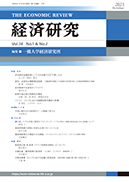Volume 74, Issue 1.2
Displaying 1-12 of 12 articles from this issue
- |<
- <
- 1
- >
- >|
Articles
-
2023Volume 74Issue 1.2 Pages 1-32
Published: October 25, 2023
Released on J-STAGE: April 30, 2024
Download PDF (2014K) -
2023Volume 74Issue 1.2 Pages 1-13
Published: October 25, 2023
Released on J-STAGE: April 30, 2024
Download PDF (4105K) -
2023Volume 74Issue 1.2 Pages 1-34
Published: October 25, 2023
Released on J-STAGE: April 30, 2024
Download PDF (2007K) -
2023Volume 74Issue 1.2 Pages 1-32
Published: October 25, 2023
Released on J-STAGE: April 30, 2024
Download PDF (1488K) -
2023Volume 74Issue 1.2 Pages 1-22
Published: October 25, 2023
Released on J-STAGE: April 30, 2024
Download PDF (1188K)
Research Note
-
2023Volume 74Issue 1.2 Pages 1-12
Published: October 25, 2023
Released on J-STAGE: April 30, 2024
Download PDF (588K)
Columns
-
2023Volume 74Issue 1.2 Pages 1-4
Published: October 25, 2023
Released on J-STAGE: April 30, 2024
Download PDF (1903K) -
2023Volume 74Issue 1.2 Pages 1-4
Published: October 25, 2023
Released on J-STAGE: April 30, 2024
Download PDF (2857K) -
2023Volume 74Issue 1.2 Pages 1-5
Published: October 25, 2023
Released on J-STAGE: April 30, 2024
Download PDF (2213K)
Book Reviews
-
2023Volume 74Issue 1.2 Pages 1-3
Published: October 25, 2023
Released on J-STAGE: April 30, 2024
Download PDF (434K) -
2023Volume 74Issue 1.2 Pages 1-3
Published: October 25, 2023
Released on J-STAGE: April 30, 2024
Download PDF (418K) -
2023Volume 74Issue 1.2 Pages 1-4
Published: October 25, 2023
Released on J-STAGE: April 30, 2024
Download PDF (438K)
- |<
- <
- 1
- >
- >|
